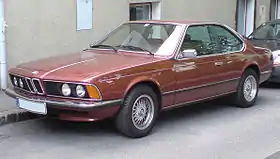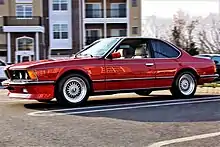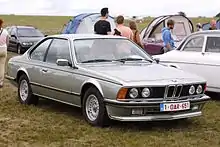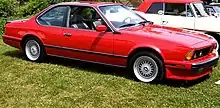BMW 6 Series (E24)
The BMW E24 is the first generation of BMW 6 Series range of grand tourer cars, which was produced from January 1976 to 1989 and replaced the BMW E9 coupé.
| BMW 6 Series (E24) | |
|---|---|
 | |
| Overview | |
| Production | 1976–1989 |
| Assembly | Germany: Karmann [1976-77] and BMW Group Plant Dingolfing 1977-1989 |
| Body and chassis | |
| Class | Grand tourer |
| Body style | 2-door coupé |
| Layout | Rear-wheel drive |
| Powertrain | |
| Engine | |
| Dimensions | |
| Wheelbase | 2,630 mm (103.5 in)[1] |
| Length | 4,755 mm (187.2 in)[1] |
| Width | 1,725 mm (67.9 in)[1] |
| Height | 1,365 mm (53.7 in)[1] |
| Curb weight | 1,450–1,619 kg (3,197–3,569 lb)[1] |
| Chronology | |
| Predecessor | BMW E9 |
| Successor | BMW 6 Series (E63) |
The E24 was produced solely in a 2-door coupé body style.[2] All models used petrol straight-six engines, with the majority (aside from the M635CSi/M6 model) using a version of the BMW M30 engine family. The E24 was initially based on the E12 5 Series platform, until it switched to the newly-released E28 5 Series platform in 1982. Considered the finest example of contemporary BMW styling, good original E24s, particularly early Karmann built examples are now quite rare and have become highly collectable, along with the later M6 and Alpina variations.
The M635CSi is the first of the BMW M6 model line and is powered by the M88/3 straight-six engine.[3] In North America, the vehicle is badged as "M6" and uses the less powerful BMW S38 engine.[4]
The E24's successor, the E63 6 Series, was released in 2004 after a 16-year hiatus. Although the E31 8 Series was released as production of the E24 was ending, the 8 Series is considered a separate model line and therefore not a successor to the E24.[5]
Development and production
The E24 was designed by Paul Bracq.[6][7][8] Unlike its E9 predecessor, the body of the E24 has a B pillar.[9] The initial proposal for the E24 was based on a BMW E9 3.0 CS with an increased height, in order to make it easier for customers to get into the car. However, Bob Lutz rejected the proposal, eventually leading to the shape of the E24 in its production form.[10]
Production started in January 1976 with the 630CS and 633CSi in February 1976.[11] A total of 86,216 cars were built prior to production ending in April 1989.[12][13]
Originally the bodies were manufactured by Karmann, but production was later taken in-house to the BMW Group Plant Dingolfing. Early series one E24s in original condition are now quite rare, particularly Karmann assembled cars produced before August 1977.[14]
Engines

Figures are for European specification models, unless otherwise stated.[12]
Engines
Figures are for European specification models, unless otherwise stated.[12]
| Model | Years | Engine | Displacement | Power | Torque |
|---|---|---|---|---|---|
| 628CSi | 1979-1987 | M30B28 | 2788 cc | 135 kW; 184 PS; 181 hp at 5,800 rpm | 235 N⋅m (173 lb⋅ft) at 4,200 rpm |
| 630CS | 1976-1979 | M30B30V | 2986 cc | 136 kW; 185 PS; 182 hp at 5,800 rpm | 255 N⋅m (188 lb⋅ft) at 3,500 rpm |
| 630CSi* | 1976-1977 | M30B30 | 176 hp (131 kW) at 5,500 rpm | 251 N⋅m (185 lb⋅ft) at 4,500 rpm | |
| 633CSi | 1976-1979 | M30B32 | 3210 cc | 147 kW; 200 PS; 197 hp at 5,500 rpm | 285 N⋅m (210 lb⋅ft) at 4,300 rpm |
| 1979-1984 | 145 kW; 197 PS; 194 hp at 5,500 rpm | 280 N⋅m (207 lb⋅ft) at 4,250 rpm | |||
| 635CSi | 1978-1982 | M90 | 3453 cc | 160 kW; 218 PS; 215 hp at 5,200 rpm | 304 N⋅m (224 lb⋅ft) at 4,000 rpm |
| 1982-1987 | M30B34 | 3430 cc | 160 kW; 218 PS; 215 hp at 5,500 rpm | 310 N⋅m (229 lb⋅ft) at 4,000 rpm | |
| 1987-1989 | M30B34 | 162 kW; 220 PS; 217 hp at 5,700 rpm | |||
| 1987-1989 | M30B35 Cat. | 155 kW; 211 PS; 208 hp at 5,700 rpm | 305 N⋅m (225 lb⋅ft) at 4,000 rpm | ||
| M635CSi | 1984-1989 | M88/3 | 3453 cc | 210 kW; 286 PS; 282 hp at 6,500 rpm | 340 N⋅m (251 lb⋅ft) at 4,500 rpm |
| M635CSi / M6* | 1987-1989 (M635CSi) / 1986-1988 (M6) | S38B35 Cat. | 191 kW; 260 PS; 256 hp at 6,500 rpm | 330 N⋅m (243 lb⋅ft) at 4,500 rpm |
* U.S. only
Transmissions
Initially, the E24 was available with a 4-speed manual transmission (Getrag 262),[15] a 5-speed manual transmission (Getrag 265),[15] or a 3-speed automatic transmission (ZF 3HP22).[16]
In 1983 the automatic transmission was upgraded to a 4-speed ZF 4HP22.[17]
Suspension and steering
Front suspension consists of MacPherson struts and the rear suspension is independent semi-trailing arms.[18] In 1982, the front suspension was upgraded to include twin-pivot lower control arms and the geometry of the rear suspension was revised.[19]
The steering uses a recirculating ball system with power assistance.[20]
M635CSi / M6 model

The M635CSi model, introduced at the Frankfurt Motor Show in 1983, is the first in the line of M6 models. In 1987, the equivalent model for the North American (U.S. and Canada) market was introduced and badged simply 'M6'.
The M635CSi is powered by a 210 kW (282 hp) version of the BMW M88/3 straight-six engine.[21] The North American M6 vehicle is powered by the detuned 191 kW (256 hp) version of the BMW S38 straight-six engine, which has a lower compression ratio and uses a catalytic converter.
Over its production run from 1983 through 1989, 5,855 M635CSi/M6 cars were built, 1,767 of which were for the North American market.[22]
Yearly changes
1976
The new 6-series coupe, coded E24, was introduced to the press in March 1976, suggesting production commenced in 1975.
Initially there where two models available, 630 CS and 633 CSI. Karmann constructed the 6 series coupe, as well as the earlier BMW coupes. There were 2072 630 CS and 2862 633 CSi totaly produced in the first year.
1977
Production of E24 continued in 1977 at Karmann as a complete assembly until August, when only the steel body shell was made by Karmann and then shipped to BMW's plant in Dingolfing for assembly. [23]
Karmann bodied cars are now extremely rare and highly collectable, particularly in original condition with early factory colours such as orange (028 phönix), green (079 Mitgrün), and yellow (070 Golf) - the later very rare.
1978
In July 1978, the more powerful 635CSi variant was introduced. The 635CSi featured a close-ratio 5-speed gearbox and a single piece black rear spoiler. The M90 engine's bigger bore and shorter stroke resulted in 160 kW (215 hp) and increased torque in models without a catalytic converter. The aerodynamic changes reduced uplift at high speeds by almost 15% over the other E24 models.[24]
1979
In 1979 the carburetted 630CS was replaced with the 628CSi;[25] this car had a fuel-injected 2.8L engine taken from the E12 528i. An anti-lock braking system became available as an option.
1980
In 1980, the fuel-injection systems changed from Bosch L-jetronic to Bosch Motronic.[26] The 635CSi central locking system could now be operated from the passenger door and trunk.
1982 facelift

In 1982 (model year 1983 in the US), the E24 platform changed from the E12 5 Series to the E28 5 Series, resulting changes to exterior styling, engines, chassis, suspension, electronics and the interior. The struts in the new front suspension were double-linked ones, making the car less likely to dip under hard braking. The new rear axle was nearly identical to the trailing arm layout of the E28 528i, with a new pitman arm to control camber changes.[27] Meanwhile, the ventilated rear discs had proven a needless complication and were replaced with solid ones.
The 635CSi engine was updated to the 3,430 cc (209 cu in) M30B34, which used a smaller bore and longer stroke than the previous 3,453 cc (211 cu in) M90 engine. The 635CSi became available with a wide-ratio 5-speed manual or a 4-speed automatic transmission.
1987
E24s produced after June 1987 were fitted with ellipsoid headlamps, as per the recently introduced E32 7 Series.[28] The front and rear bumpers and spoilers were redesigned to use a single design worldwide[29] (prior to this, models sold in North America used a different design from the rest of the world).
The 635CSi engine was updated to the higher compression M30B35,[30] which resulted in a power increase of 19 kW (25 hp) for engines with catalytic converters.
North American and Japanese models
The extended bumpers required by U.S. crash legislation resulted in U.S models having an increase in length of approximately 180 mm (7.1 in) to 4,923 mm (193.8 in). Although other markets offered multiple E24 models, in North America only one model was available at any given time (aside from the M6).
630CSi
The 6 series was released in the US as the 630CS in 1976), with the 633 CSI replacing it in September 1977. The 630CSi is powered by a fuel-injected version of the 630CS engine. This 3.0 litre engine produces 131 kW (176 hp) and 251 N⋅m (185 lbf⋅ft).
633CSi
The 630CSi and 633csi were released in 1976 however in USA the 633csi did not arrive until September 1977.[31] In United States/Japan specification, the 633CSi was powered by a 135 kW (181 hp) version of the M30B32 engine. Output later dropped to 130 kW (174 hp).
In September 1980 (1981 model year), the manual transmission for US cars was upgraded from a 4-speed to a 5-speed. A 3-speed automatic transmission was optional.[32]
In September 1982, North American and Japanese market models received a major facelift, as per the models sold in the rest of the world.
635CSi

In 1985, the 633CSi was replaced by the 635CSi for the North American Market.[33] This model uses the M30B34 engine, which produces 136 kW (182 hp) and 290 N⋅m (214 lbf⋅ft) at 4,000 rpm. An L6 "luxury edition" version of the 635CSi was available in North America for the 1987 model year. The L6 featured leather headliner and trim and an automatic gearbox.[34]
In 1988, the engine was upgraded to the M30B35. This engine has a capacity of 3.4 Litres (despite the model code and the "3.5" inscribed on the intake manifold) and produces 155 kW (208 hp) and 305 N⋅m (225 lbf⋅ft) torque. This upgraded engine resulted in catalytic converter equipped United States models offering similar performance to European models.[33] Self-leveling rear suspension was added to the 635CSi and M6 features list.[33]
M6

In 1987, North America and Japan received their equivalent of the M635CSi, called simply the M6. The main difference between the M6 and its European counterpart, is that the S38 engine is used instead of the M88. Compared with the M88, the S38 has a catalytic converter, the compression ratio reduced to 9.8:1, a double row timing chain, a shorter camshaft duration and a simplified exhaust manifold. The power output for the North American E24 M6 is 256 hp (191 kW), which is 22 kW (30 hp) less than the European M635CSi.[22]
Standard equipment on the United States market M6 cars included many features which were optional on the European cars, including heated power seats, self-leveling rear suspension, beverage chiller (cooled by an air-conditioning system) between the rear seats, air-conditioning vents for rear seat occupants, sunshade for rear occupants and an 8 speaker premium sound system.[35]
Motorsport
Achievements in championships and series:
- European Touring Car Championship; 3 titles (1981, 1983 and 1986)
- Deutsche Tourenwagen Meisterschaft; 1 title (1984)
- Belgian Touring Car Championship (Group N); 1 title (1984)
- Australian Touring Car Championship; 1 title (1985)
- Australian Endurance Championship; 2 titles (1985 and 1986)
- Australian Manufacturers' Championship; 1 title (1985)
- AMSCAR Series; 1 title (1985)
- European Hill Climb Championship; 1 title (1985)
- New Zealand Touring Car Championship; 2 titles (1985 and 1987)
- New Zealand Benson & Hedges Saloon Car Series; 1 title (1985)
- Nissan-Mobil 500 Series (New Zealand); 1 title (1985)
- Japanese Touring Car Championship; 1 titles (1985)
Race wins:
- RAC Tourist Trophy; 2 wins (1980 and 1984)
- 4h/500 km of Monza; 3 wins (1980, 1981 and 1983)
- Guia Race; 1 win (1983)
- Spa 24 Hours; 3 wins (1983, 1985 and 1986)
- 24 Hours Nürburgring; 2 wins (1984 and 1985)
- Sandown 500; 1 win (1985)
References
- "BMW 628 CSi 635CSi TECHNISCHE BESCHREIBUNG" (PDF). BMW. Retrieved 19 February 2019.
- "The first BMW 6 Series model. E24 history". BMW BLOG. 2014-07-23. Archived from the original on 2017-08-29. Retrieved 2017-08-29.
- "BMW M635CSi: Shark in a sharp suit". www.classicdriver.com. Retrieved 2017-08-29.
- "6'E24 M6 model selection". www.realoem.com. Retrieved 17 April 2017.
- "The 8-Series Was One Of BMW's Best Failed Experiments". www.jalopnik.com. Retrieved 18 April 2017.
- Norbye, Jan P. (1984). BMW - Bavaria's Driving Machines. Skokie, IL: Publications International. p. 220. ISBN 0-517-42464-9.
- "Status-Seeking Missiles: The BMW E24 6-Series Coupes". www.ateupwithmotor.com. Retrieved 8 May 2014.
- Lewin, Tony. The Complete Book of BMW: Every Model since 1950. Motorbooks International. p. 111. ISBN 0-7603-1951-0.
- "BMW E24 Six Series". www.unixnerd.demon.co.uk. Retrieved 6 May 2017.
- Lutz, Robert A. (2003). Guts: 8 Laws of Business from One of the Most Innovative Business Leaders of Our Time. Wiley and Sons.
- "BMW Classic - Recherche-Client". bmw-grouparchiv.de.
- Oswald, Werner (2001). Deutsche Autos 1945-1990, Band 4 (in German). Motorbuch Verlag. ISBN 3-613-02131-5.
- "Model selection - 6'E24 - Coupe - 635CSi - EUR - 04/1989". www.realoem.com. Retrieved 9 November 2019.
- "Schnell, geräumig, sparsam, leise" [Fast, spacious, economical, quiet] (in German).
- "6' E24 633CSi Manual gearbox". www.realoem.com. Retrieved 24 April 2017.
- "6' E24 633CSi Automatic transmission". www.realoem.com. Retrieved 24 April 2017.
- "6' E24 628CSi Automatic transmission". www.realoem.com. Retrieved 24 April 2017.
- "BMW E24 Giant Test from 628CSi, 633CSi, 635CSi, to M635CSi and Alpina B9 3.5". www.drive-my.com. Retrieved 24 April 2017.
- "Status-Seeking Missiles: The BMW E24 6-Series Coupes". www.ateupwithmotor.com. Retrieved 24 April 2017.
- "BMW E24 Mechanicals". www.unixnerd.demon.co.uk. Retrieved 24 April 2017.
- "1984 - 1989 BMW M635 CSi Specifications". www.ultimatecarpage.com. Retrieved 27 Jan 2018.
- "FAQ E24 M635CSi/M6". www.bmwmregistry.com. Retrieved 3 October 2010.
- "Model Evolution - 1977". www.e-24.ru. Retrieved 6 May 2017.
- "Model Evolution - 1978". www.e-24.ru. Retrieved 6 May 2017.
- "Model Evolution - 1979". www.e-24.ru. Retrieved 6 May 2017.
- "Model Evolution - 1980". www.e-24.ru. Retrieved 6 May 2017.
- Haventon, Peter (1982-08-11). "Fintrimmad" [Tuned up]. Teknikens Värld (in Swedish). Vol. 34 no. 17. Stockholm, Sweden: Specialtidningsförlaget AB. p. 23.
- "Model Evolution - 1987". www.e-24.ru. Retrieved 24 October 2010.
- "6' E24 635CSi Front Spoiler M Technic". www.realoem.com. Retrieved 7 May 2017.
- "6' E24 635CSi Volume air flow sensor". www.realoem.com. Retrieved 22 April 2017.
- "6'E24 630 CSi - model selection". www.realoem.com. Retrieved 11 May 2017.
- "Road Test Annual & Buyer's Guide 1981". Road & Track (Jan-Feb 1981): 84.
- Covello, Mike (2002). Standard Catalog of Imported Cars 1946-2002. Krause Publications. ISBN 0-87341-605-8.
- Martin, Murilee. "1987 BMW L6". Jalopnik. Retrieved 2017-08-29.
- "1987 BMW M6 - Archived Road Test Page 2". www.caranddriver.com. Retrieved 13 May 2017.
| Wikimedia Commons has media related to BMW E24. |
